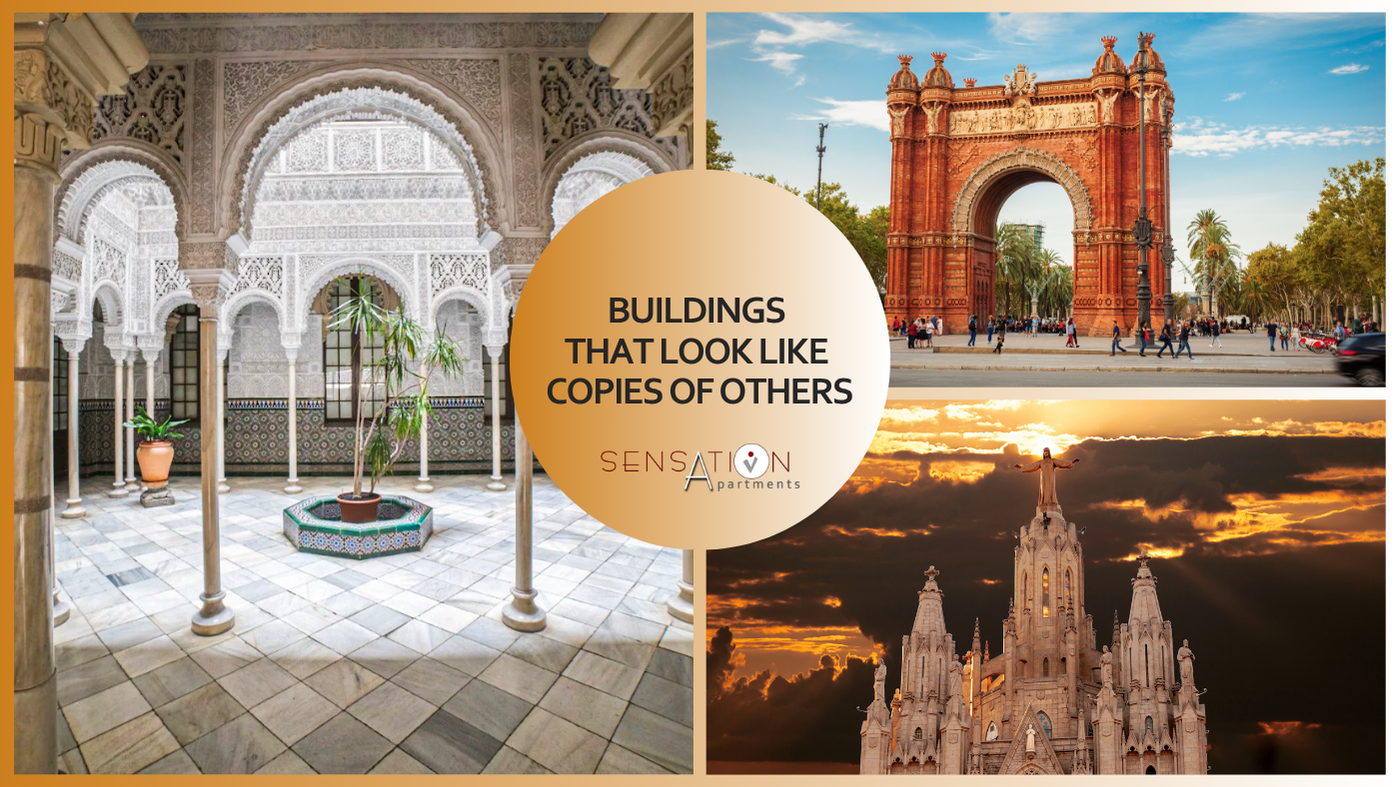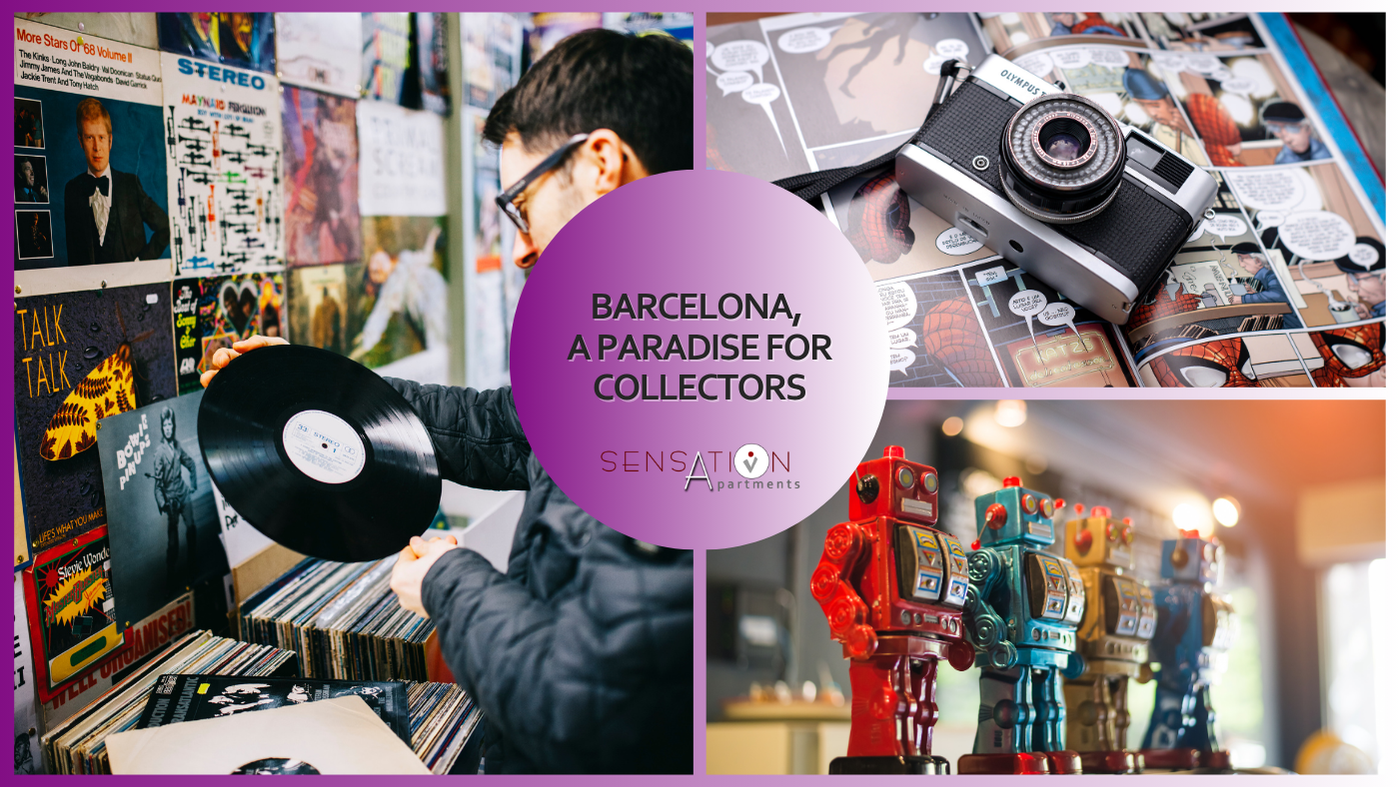Buildings that look like copies of others
Routes 02/07/2025
Barcelona never ceases to amaze. Its unique architecture is part of its identity, but it also hides nods, tributes, and similarities with other corners of the world. Some buildings in the city evoke the Milan Opera House, the Alhambra in Granada, Imperial Vienna, or even New York's Flatiron Building.
In this article, we suggest a unique and highly photogenic route, ideal for families and groups of friends: discover Barcelona's buildings that look like they're straight out of other cities or countries. Ready to see Barcelona through fresh eyes?
The Andreu Tower: the “Flatiron” of Barcelona
Diagonal with Passeig de Gràcia
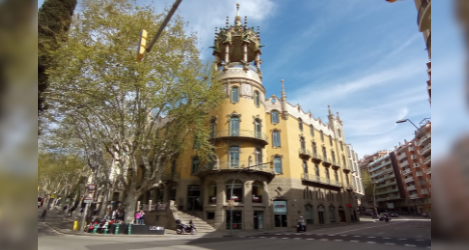
This building, also known as the House of Dr. Genové, stands out for its stylized triangular shape, located at a busy intersection. Like the Flatiron Building in New York, its unique geometry makes it an iconic image.
Built in the early 20th century, it is an example of elegant and functional modernism. Today, it stands out for its sobriety and symmetry, and many visitors can't help but think they're in Manhattan... until they hear Catalan spoken.
The Temple of the Sacred Heart: a Sacré-Cœur with a view
Tibidabo
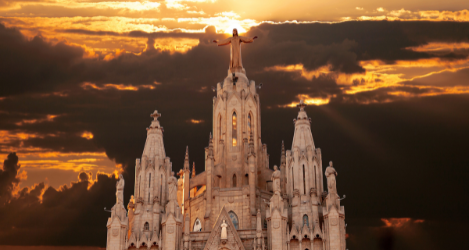
The Expiatory Church of the Sacred Heart of Jesus dominates the city from the top of Tibidabo. Its resemblance to the Sacré-Cœur Basilica in Paris is evident: both are on a hill, made of light-colored stone, and crowned by a monumental statue.
Designed by Enric Sagnier and completed by his son, this church combines neo-Gothic and Byzantine styles. It's ideal for a family visit: the funicular ride, the panoramic views, the amusement park, and the peaceful atmosphere make it an unforgettable experience.
The Mies van der Rohe Pavilion: Berlin on Montjuïc
Avinguda Francesc Ferrer i Guàrdia, Montjuïc
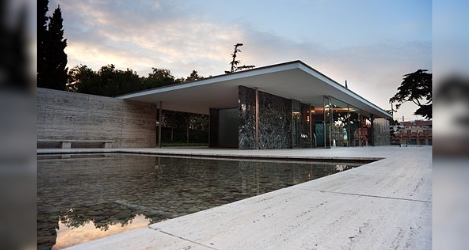
This building is a faithful reconstruction of the German pavilion created for the 1929 International Exhibition. Its designer, architect Ludwig Mies van der Rohe, is one of the key figures of the European modern movement.
Minimalism, proportion, noble materials (marble, glass, steel), and a serene atmosphere make the pavilion a haven of peace amidst the bustle of tourism. It's ideal for a leisurely visit, whether as a couple or with friends curious about design and the history of architecture.
Colonia Güell: a European village with a Catalan essence
Santa Coloma de Cervelló
About 20 minutes from downtown Barcelona lies this 19th-century industrial settlement, designed by Eusebi Güell and decorated with an unfinished Gaudí church. Its low-rise houses, quiet streets, and modernist details are reminiscent of Central European villages, but with a Catalan soul.
Gaudí's crypt, a World Heritage Site, is a fascinating work where the architect experimented with many of the ideas he would later apply to the Sagrada Familia. A visit to the colony is perfect for a day out with children, away from the crowds.
Arc de Triomphe: first cousin of the Arc de Triomphe in Paris
Lluís Companys Promenade
![]()
Built as the main entrance to the 1888 World's Fair, Barcelona's Arc de Triomphe bears formal similarities to its Parisian counterpart: a monumental, classically inspired arch designed to celebrate achievements and welcome visitors.
Unlike the French one, this one is made of red brick and features Art Nouveau decorative reliefs. Surrounding it is a wide promenade ideal for walking, skating, or relaxing with children. Nearby is Parc de la Ciutadella, another must-see for family visitors.
The Military Government: La Scala in Milan on the Pla de Palau
Palau Square
![]()
This majestic neoclassical building surprises anyone who suddenly encounters it in the square. Its columns, balconies, and staircase are reminiscent of Milan's famous Teatro alla Scala. Although it currently serves administrative and military purposes, its façade conveys the solemnity and elegance of the great 19th-century European theaters.
It's located in a historic area, next to the sea and near the old port. Ideal for combining with a tour of El Born and Barceloneta.
Casa Ferrer Cajigal: a fairytale castle in Sant Joan
Passeig de Sant Joan, 108
This modernist building is a true hidden gem. Built in 1906 by Salvador Vinyals, it resembles a Central European fairytale house, with domes, pointed towers, floral details, and a romantic atmosphere reminiscent of cities like Vienna or Prague.
Despite its spectacular nature, it's not as well-known as other modernist buildings in the city, making it an ideal spot for a quiet, photogenic stop.
Alhambra Building: Neo-Mudejar inspiration in the heart of Gran Via
Gran Via de les Corts Catalanes, 658
![]()
This unique building stands out for its neo-Mudejar aesthetic, with horseshoe arches, exposed brick, decorative ceramics, and details that clearly evoke the Alhambra in Granada.
Built in the late 19th century, it's an architectural rarity in Barcelona's Eixample district. It's currently a residential building, but its exterior is well worth a photo. A gem for lovers of the Andalusian style and multicultural influences in Catalan architecture.
Santa Maria Reina: basilica elegance
Passeig de la Bonanova, 101
![]()
This Catholic church, located in the Sarrià-Pedralbes neighborhood, has a sober and monumental structure reminiscent of the great Italian basilicas. Built in the 1940s, it stands out for its clean lines, dome, and imposing staircase entrance.
It is little known among visitors, but it is very interesting for those seeking serene corners, full of spirituality and classical beauty.
Poble Espanyol: a miniature Spain
Avinguda Francesc Ferrer i Guàrdia, 13, Montjuïc
![]()
The Poble Espanyol is a unique example, as it is not a coincidental resemblance, but rather an intentional recreation of architecture from all over Spain. Built for the 1929 International Exposition, it brings together more than 100 buildings that reproduce houses, squares, and streets from different regions.
It's a perfect place for families: it offers workshops, craft shops, regional restaurants, children's activities, and exhibitions. A stroll through Poble Espanyol is a fun and educational way to explore the country without leaving Montjuïc.
This route not only offers a different perspective on the city, but also invites you to explore with a curious eye and enjoy, as a group or as a family, places not mentioned in the guidebooks but that have much to offer.
Are you up for following this similarities? Tell us which one was your favorite and tag @sensation_apartments_barcelona in your photos. We'd love to share your experience!
In this article, we suggest a unique and highly photogenic route, ideal for families and groups of friends: discover Barcelona's buildings that look like they're straight out of other cities or countries. Ready to see Barcelona through fresh eyes?
The Andreu Tower: the “Flatiron” of Barcelona
Diagonal with Passeig de Gràcia

This building, also known as the House of Dr. Genové, stands out for its stylized triangular shape, located at a busy intersection. Like the Flatiron Building in New York, its unique geometry makes it an iconic image.
Built in the early 20th century, it is an example of elegant and functional modernism. Today, it stands out for its sobriety and symmetry, and many visitors can't help but think they're in Manhattan... until they hear Catalan spoken.
The Temple of the Sacred Heart: a Sacré-Cœur with a view
Tibidabo

The Expiatory Church of the Sacred Heart of Jesus dominates the city from the top of Tibidabo. Its resemblance to the Sacré-Cœur Basilica in Paris is evident: both are on a hill, made of light-colored stone, and crowned by a monumental statue.
Designed by Enric Sagnier and completed by his son, this church combines neo-Gothic and Byzantine styles. It's ideal for a family visit: the funicular ride, the panoramic views, the amusement park, and the peaceful atmosphere make it an unforgettable experience.
The Mies van der Rohe Pavilion: Berlin on Montjuïc
Avinguda Francesc Ferrer i Guàrdia, Montjuïc

This building is a faithful reconstruction of the German pavilion created for the 1929 International Exhibition. Its designer, architect Ludwig Mies van der Rohe, is one of the key figures of the European modern movement.
Minimalism, proportion, noble materials (marble, glass, steel), and a serene atmosphere make the pavilion a haven of peace amidst the bustle of tourism. It's ideal for a leisurely visit, whether as a couple or with friends curious about design and the history of architecture.
Colonia Güell: a European village with a Catalan essence
Santa Coloma de Cervelló
About 20 minutes from downtown Barcelona lies this 19th-century industrial settlement, designed by Eusebi Güell and decorated with an unfinished Gaudí church. Its low-rise houses, quiet streets, and modernist details are reminiscent of Central European villages, but with a Catalan soul.
Gaudí's crypt, a World Heritage Site, is a fascinating work where the architect experimented with many of the ideas he would later apply to the Sagrada Familia. A visit to the colony is perfect for a day out with children, away from the crowds.
Arc de Triomphe: first cousin of the Arc de Triomphe in Paris
Lluís Companys Promenade
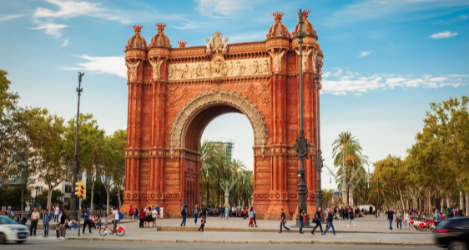
Built as the main entrance to the 1888 World's Fair, Barcelona's Arc de Triomphe bears formal similarities to its Parisian counterpart: a monumental, classically inspired arch designed to celebrate achievements and welcome visitors.
Unlike the French one, this one is made of red brick and features Art Nouveau decorative reliefs. Surrounding it is a wide promenade ideal for walking, skating, or relaxing with children. Nearby is Parc de la Ciutadella, another must-see for family visitors.
The Military Government: La Scala in Milan on the Pla de Palau
Palau Square
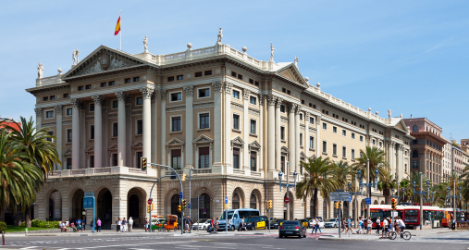
This majestic neoclassical building surprises anyone who suddenly encounters it in the square. Its columns, balconies, and staircase are reminiscent of Milan's famous Teatro alla Scala. Although it currently serves administrative and military purposes, its façade conveys the solemnity and elegance of the great 19th-century European theaters.
It's located in a historic area, next to the sea and near the old port. Ideal for combining with a tour of El Born and Barceloneta.
Casa Ferrer Cajigal: a fairytale castle in Sant Joan
Passeig de Sant Joan, 108
This modernist building is a true hidden gem. Built in 1906 by Salvador Vinyals, it resembles a Central European fairytale house, with domes, pointed towers, floral details, and a romantic atmosphere reminiscent of cities like Vienna or Prague.
Despite its spectacular nature, it's not as well-known as other modernist buildings in the city, making it an ideal spot for a quiet, photogenic stop.
Alhambra Building: Neo-Mudejar inspiration in the heart of Gran Via
Gran Via de les Corts Catalanes, 658
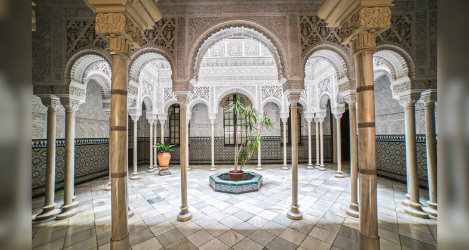
This unique building stands out for its neo-Mudejar aesthetic, with horseshoe arches, exposed brick, decorative ceramics, and details that clearly evoke the Alhambra in Granada.
Built in the late 19th century, it's an architectural rarity in Barcelona's Eixample district. It's currently a residential building, but its exterior is well worth a photo. A gem for lovers of the Andalusian style and multicultural influences in Catalan architecture.
Santa Maria Reina: basilica elegance
Passeig de la Bonanova, 101
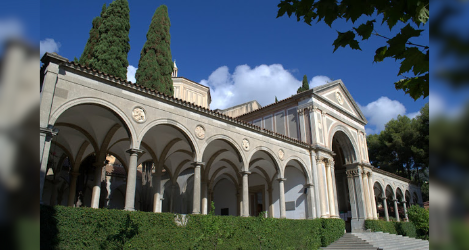
This Catholic church, located in the Sarrià-Pedralbes neighborhood, has a sober and monumental structure reminiscent of the great Italian basilicas. Built in the 1940s, it stands out for its clean lines, dome, and imposing staircase entrance.
It is little known among visitors, but it is very interesting for those seeking serene corners, full of spirituality and classical beauty.
Poble Espanyol: a miniature Spain
Avinguda Francesc Ferrer i Guàrdia, 13, Montjuïc
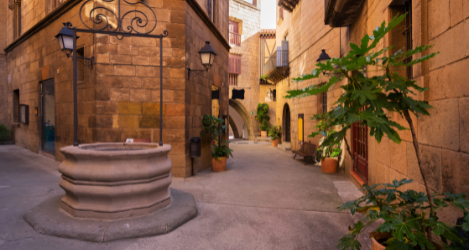
The Poble Espanyol is a unique example, as it is not a coincidental resemblance, but rather an intentional recreation of architecture from all over Spain. Built for the 1929 International Exposition, it brings together more than 100 buildings that reproduce houses, squares, and streets from different regions.
It's a perfect place for families: it offers workshops, craft shops, regional restaurants, children's activities, and exhibitions. A stroll through Poble Espanyol is a fun and educational way to explore the country without leaving Montjuïc.
This route not only offers a different perspective on the city, but also invites you to explore with a curious eye and enjoy, as a group or as a family, places not mentioned in the guidebooks but that have much to offer.
Are you up for following this similarities? Tell us which one was your favorite and tag @sensation_apartments_barcelona in your photos. We'd love to share your experience!

